Slimline Water Tanks: The Perfect Choice for Urban Water Storage
Slimline Water Tanks: The Perfect Choice for Urban Water Storage
Blog Article
Comprehending the Value of Rain Containers in Drought-Prone Regions for Water Security
In areas vulnerable to prolonged droughts, the function of rainwater tanks in strengthening water safety is a topic of expanding significance. As communities come to grips with the challenges of water deficiency, comprehending the significance of these storage tanks surpasses simple collection of rainwater. Rainwater containers serve as a vital tool in minimizing the effect of water scarcities by offering a lasting source of water for different needs. The true value of rain tanks prolongs much past mere storage space; it encompasses resilience-building procedures and the promo of long-term water conservation approaches. This multifaceted method to water protection warrants a closer evaluation of the function rainwater containers play in ensuring a trusted supply of water throughout times of dry spell.
Benefits of Rain Tanks
Utilizing rain containers offers a sustainable service for increasing water system and improving water safety in property and industrial settings. One of the primary benefits of rain containers is their capability to minimize reliance on mains water supply. By recording and saving rain that falls on rooftops, this different resource can be utilized for different non-potable purposes such as watering, flushing toilets, and cleaning clothing. This not only conserves cured alcohol consumption water however also decreases water bills for customers.

Rainwater Harvesting Methods
Rainwater collecting methods include a range of approaches developed to efficiently accumulate and save rain for various objectives, contributing to water conservation and sustainability. An additional popular strategy is the use of above-ground or underground storage space tanks to save rainwater for later usage.

Moreover, rainfall gardens and absorptive pavements are ingenious strategies that involve landscaping or paving surface areas in a manner that allows rainwater to percolate into the ground, replenishing groundwater reserves. Furthermore, shape farming and terracing are farming practices that help catch rain and prevent soil erosion in sloping terrain. By applying these varied rain harvesting strategies, communities can enhance water protection and resilience in drought-prone regions while promoting sustainable water administration methods.
Relevance of Water Security
Guaranteeing reliable access to clean and sufficient water resources is critical for sustaining human health, economic development, and environmental well-being. Water security is an important element of social durability, especially in regions vulnerable to droughts and water scarcity. Sufficient water safety and security includes various dimensions, including schedule, top quality, and access of water for residential, farming, industrial, and environmental needs.
Water security plays a crucial duty in advertising public health and wellness by decreasing the prevalence of waterborne diseases and making certain hygiene centers. Financially, water protection is essential for farming efficiency, industrial procedures, and general economic development. Slimline water tanks. Additionally, water safety is closely linked to environmental sustainability, as it sustains environments, biodiversity, and overall ecological equilibrium.
In drought-prone regions, water security comes to be even much more important due to the increased risk of water shortages. Applying techniques like rain harvesting, water recycling, and effective water management methods can significantly boost water safety and security in these locations. By prioritizing water safety, communities can better hold up against the impacts of environment adjustment, populace growth, and various other obstacles that threaten water schedule.
Enhancing Water Strength
With enhancing worldwide water obstacles, building durability in water supply has actually become a vital focus for sustainable advancement initiatives. Enhancing water strength involves carrying out approaches to ensure water availability and high quality despite transforming ecological conditions, such as droughts, floodings, investigate this site and pollution.
One trick aspect of improving water durability is advertising making use of rain containers in drought-prone areas - Slimline water tanks. Rain containers work as an effective means of catching and saving rainwater weblink for later usage, reducing reliance on scarce freshwater resources throughout completely dry durations. By integrating rainwater harvesting systems into water administration plans, areas can enhance their ability to endure water shortage and preserve water safety and security

Lasting Water Preservation
Amidst escalating water difficulties, the sensible monitoring of water resources through sustainable conservation methods is essential for guaranteeing long-lasting ecological security and societal health. Sustainable water conservation involves the reliable usage of water sources to meet current needs without jeopardizing the capability of future generations to satisfy their very own demands. By carrying out strategies such as rainwater harvesting, greywater hop over to these guys recycling, and water-efficient technologies, neighborhoods can decrease water waste and ease stress on freshwater sources.
Moreover, sustainable water conservation practices contribute to ecosystem health by maintaining adequate water degrees in rivers, lakes, and marshes, sustaining biodiversity, and maintaining all-natural environments. These methods likewise play an important function in reducing the impacts of environment adjustment by assisting to adapt to changing precipitation patterns and water schedule.

Conclusion
Finally, rain tanks play an important duty in enhancing water safety and security and strength in drought-prone areas. By utilizing rainwater harvesting strategies, areas can reduce their reliance on standard water resources and advertise sustainable water conservation methods. This not only aids minimize the impacts of water scarcity during droughts however additionally adds to lasting water security and durability when faced with climate modification obstacles.
Report this page